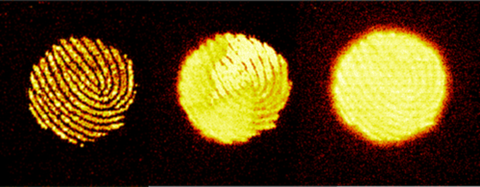Summary
The goal of this focus area is to leverage the wealth of chemical information present in fingerprint deposits for novel forensic applications. This includes understanding the role and presence of both endogenous and exogenous components, the chemical and psychical processes that fingerprints undergo, and development of standards to address the needs of traditional fingerprint development.
Description
Verification Test Materials (VTMs) for Fingerprint Developing Reagents
The forensic community has no quantifiable QA/QC method for determining the efficacy of fingerprint developing reagents prior to use in casework. Reagents can be exposed to environmental conditions in the field that can expedite degradation. This project aims to develop proof-of-concept VTM to evaluate the stability of fingerprint developing reagents, a quantifiable method to determine efficacy of a reagent as a function of time (varying concentrations of serine) and establish stability and shelf-life of traditional development reagents (i.e. ninhydrin). This project also aims to develop chemically relevant fingerprint materials to allow for more reproducibility evaluation of fingerprint developer reagents.
Relevant Publications
- A chemically relevant articificial fingerprint material for the cross-comparison of mass spectrometry techniques (https://doi.org/10.1080/00085030.2015.1083167)
Age Dating of Fingerprints
Age dating of fingerprints could have a significant impact in forensic science, as it has the potential to facilitate the judicial process by assessing the relevance of a fingerprint found at a crime scene. However, no method currently exists that can reliably predict the age of a latent fingerprint. In this project, time-of-flight secondary ion imaging mass spectrometry (TOF-SIMS) is being investigated as a potential tool for this application. An example of fatty acid diffusion, which can be measured and imaged using TOF-SIMS is presented below.

Relevant Publications:
- Strategies for Potential Age Dating of Fingerprints through the Diffusion of Sebum Molecules on a Nonporous Surface Analyzed Using Time-of-Flight Secondary Ion Mass Spectrometry (https://doi.org/10.1021/acs.analchem.5b02018)

